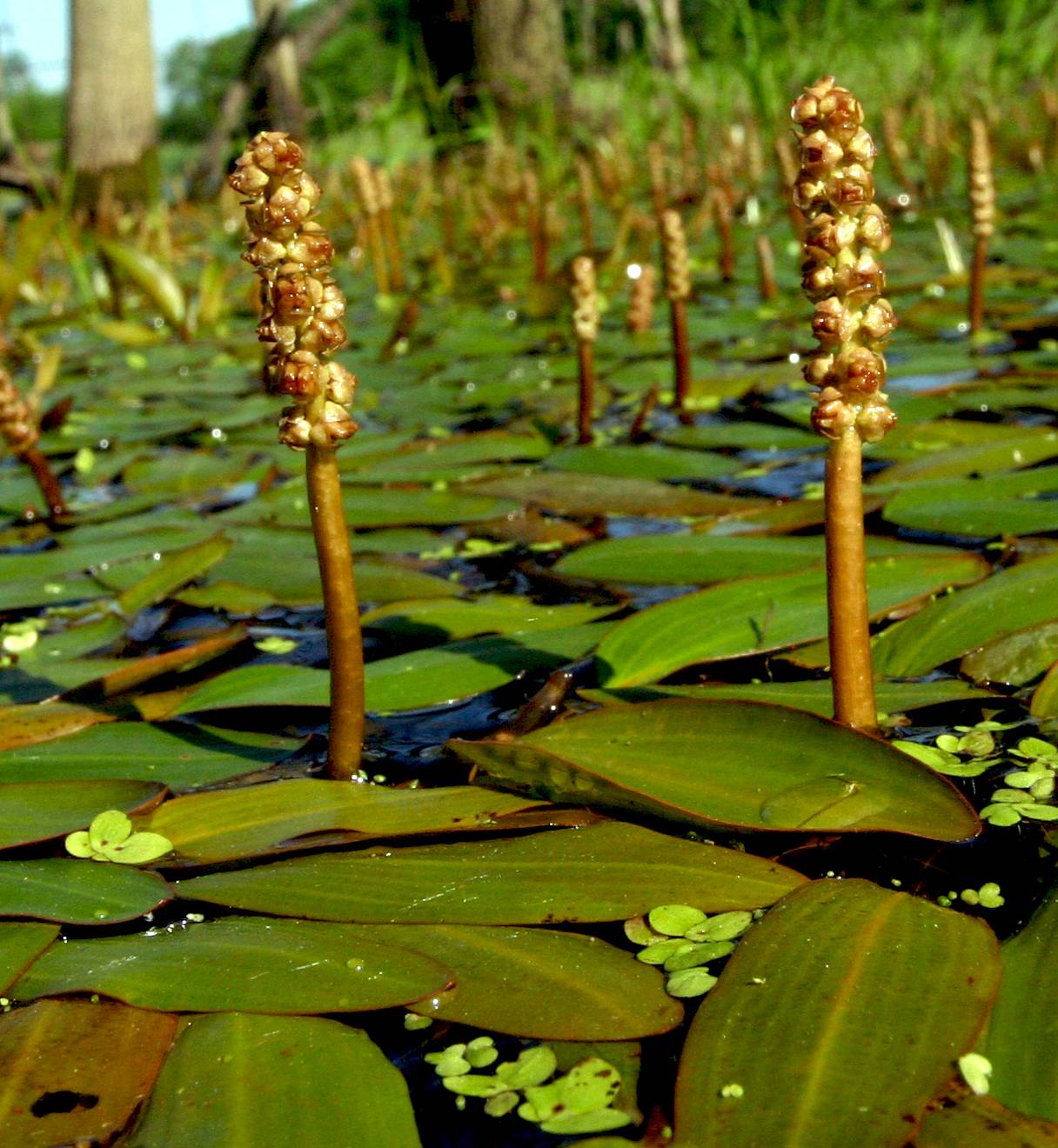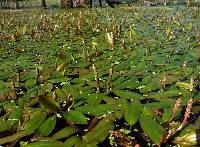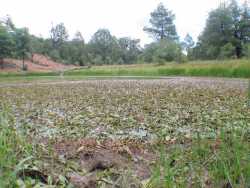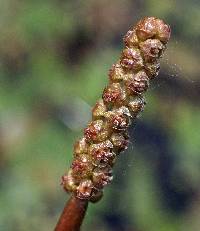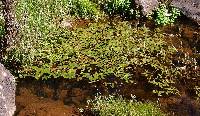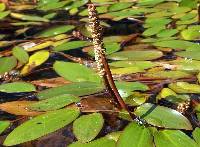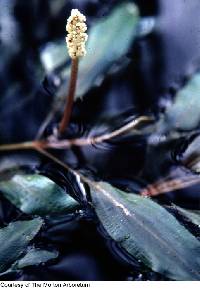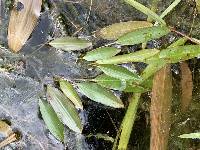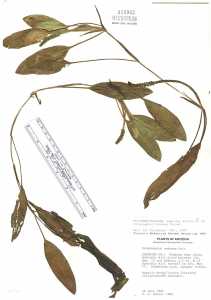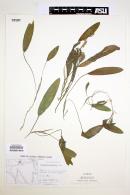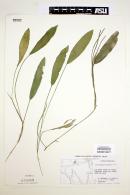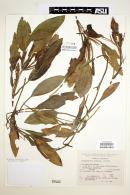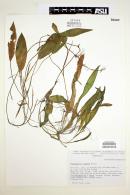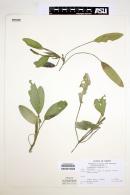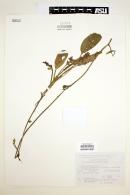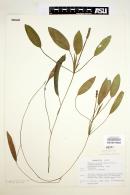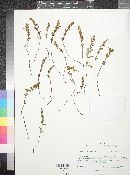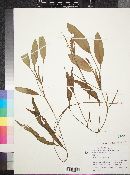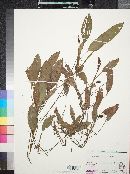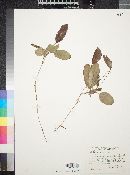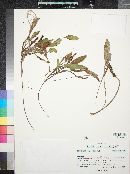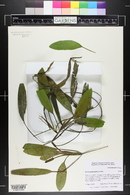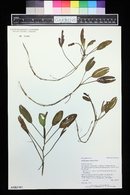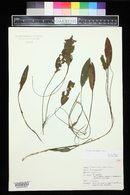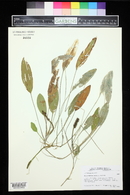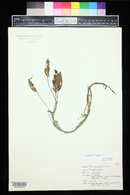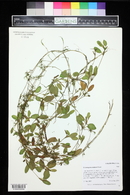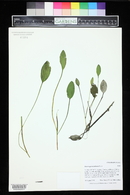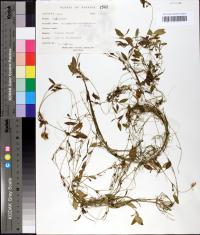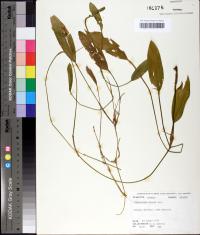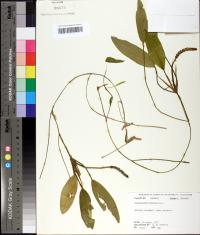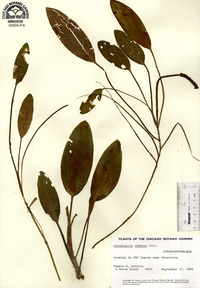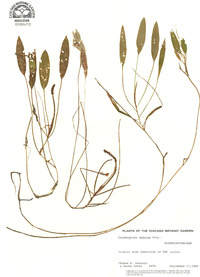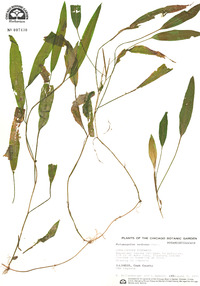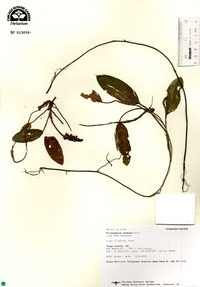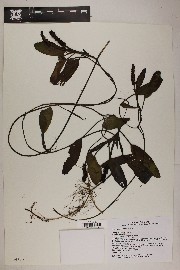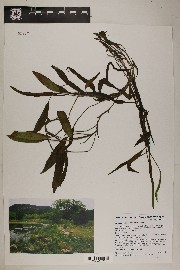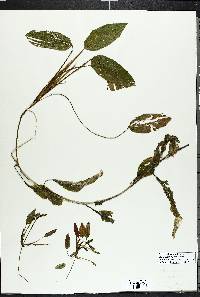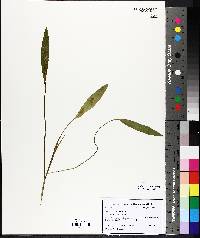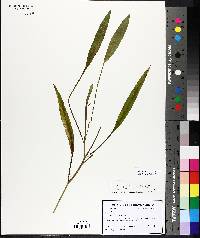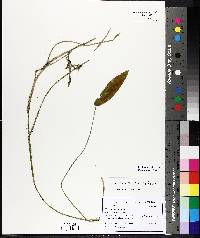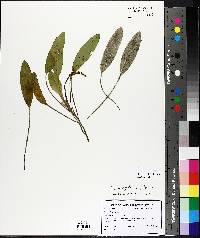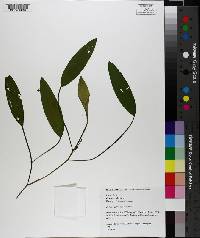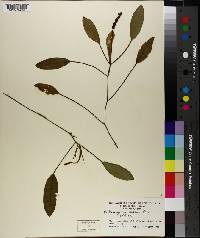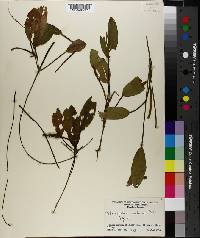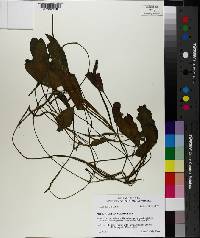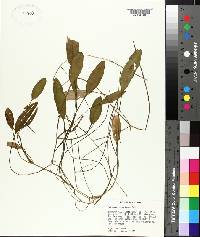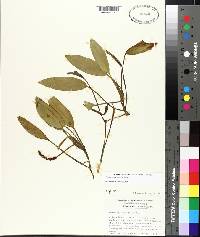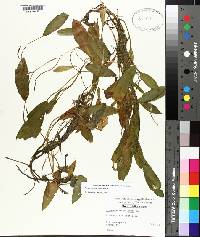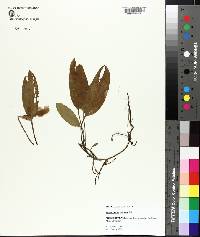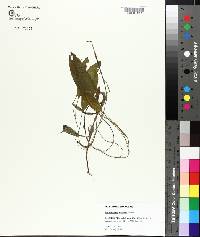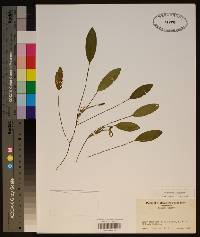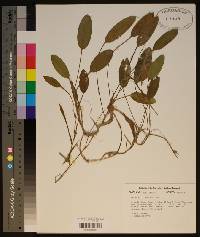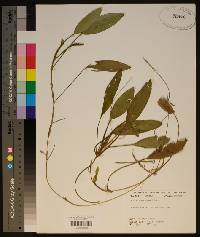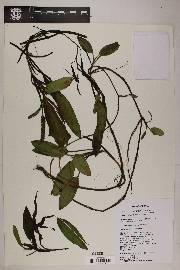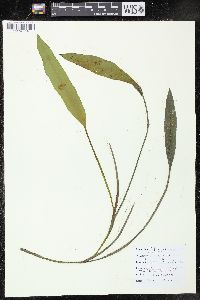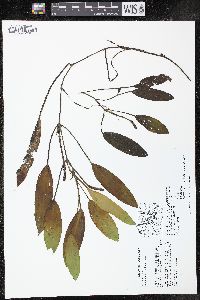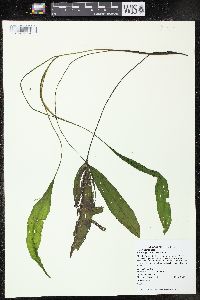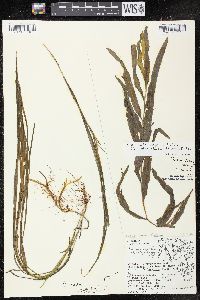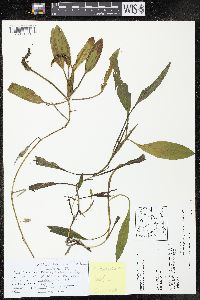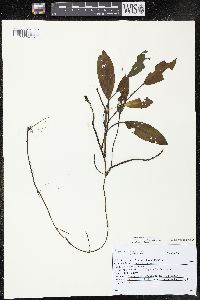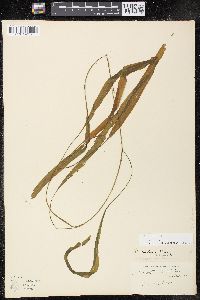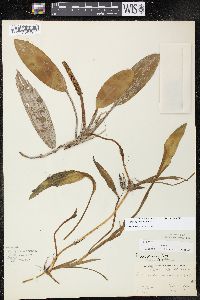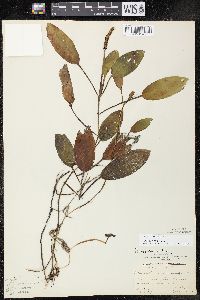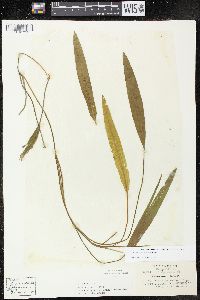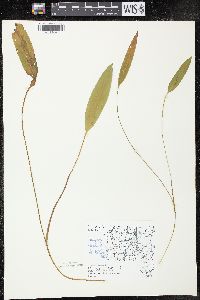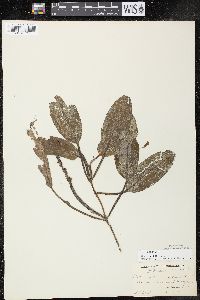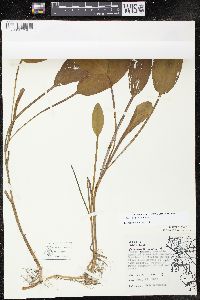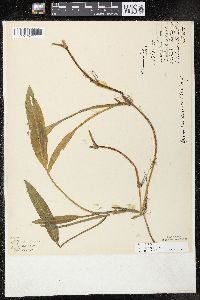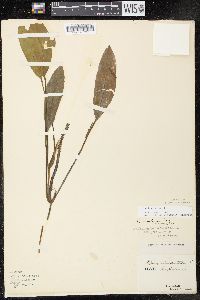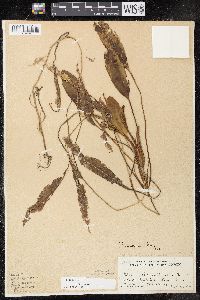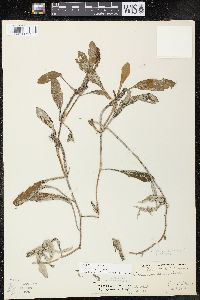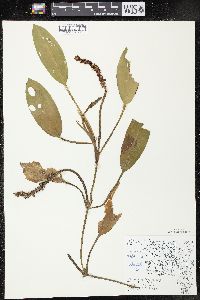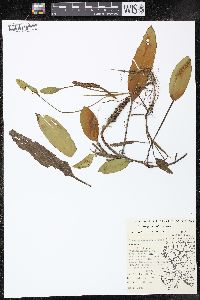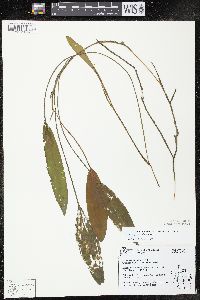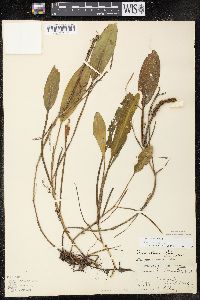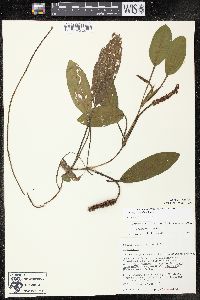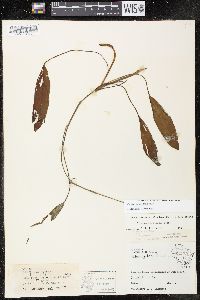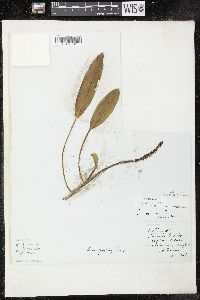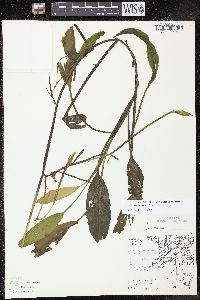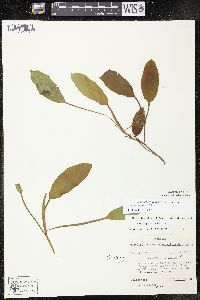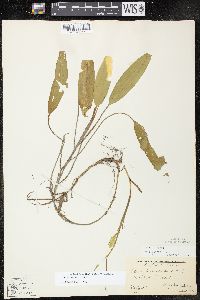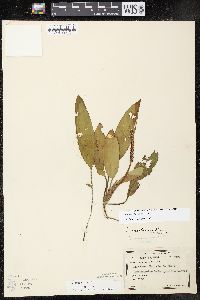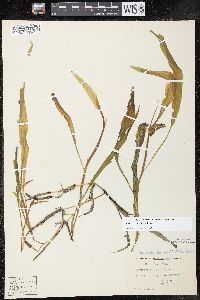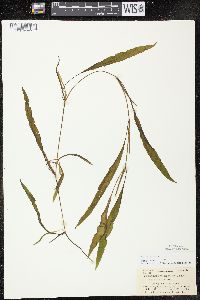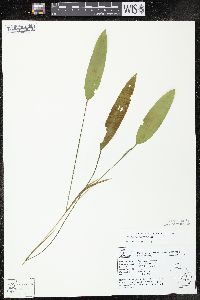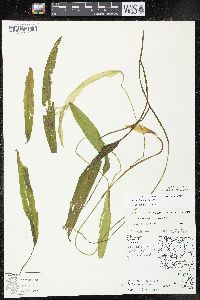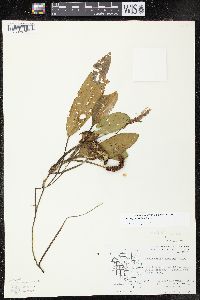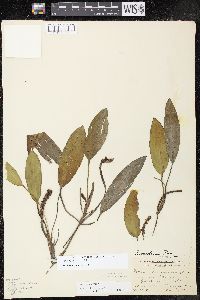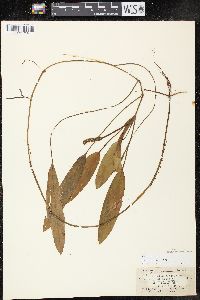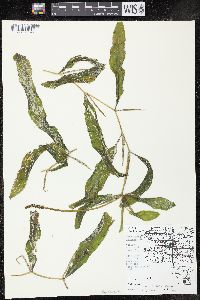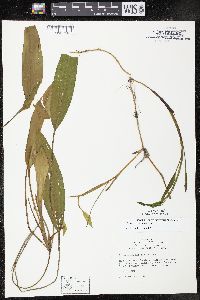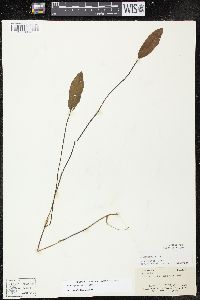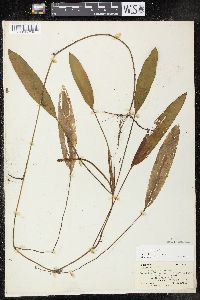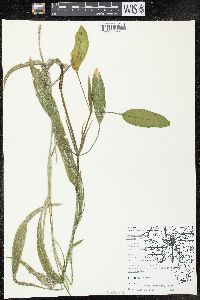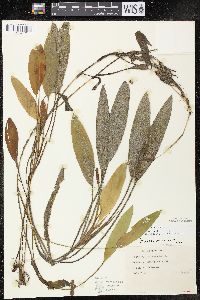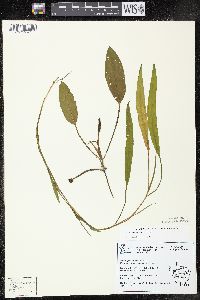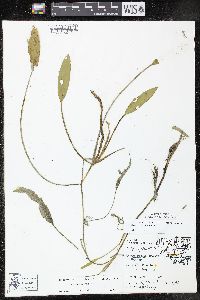Potamogeton nodosus
|
|
|
|
Family: Potamogetonaceae
Long-Leaf Pondweed, more...longleaf pondweed
[Potamogeton americanus Cham. & Schlecht., morePotamogeton americanus var. novaeboracensis (Morong) A.Benn., Potamogeton drucei Fryer, Potamogeton fluitans Roth, Potamogeton lonchites Tuck., Potamogeton lonchites var. novaeboracensis , Potamogeton mascarensis Cham. & Schltdl., Potamogeton mexicanus , Potamogeton stagnorum Hagstr., Potamogeton thunbergii Cham. & Schltdl., Potamogeton ×fluitans subsp. americanus Graebn., Potamogeton ×fluitans var. canariensis (Link) Webb & Berthel.] |
Rhizomes present. Cauline stems terete, without spots, to 100 cm; nodal glands absent. Turions absent. Leaves both submersed and floating, or floating absent, ± spirally arranged. Submersed leaves petiolate, lax; stipules persistent to deliquescent, conspicuous, convolute, free from blade, light brown, not ligulate, 3--9 cm, not fibrous, not shredding at tip, apex round to acute; petioles 2--13 cm; blade light to dark green, linear-lanceolate to lance-elliptic, not arcuate, 9--20 cm ´ 10--35 mm, base acute, without basal lobes, not clasping, margins entire, not crispate, apex not hoodlike, acute, without sharp awl-like tip, lacunae in 2--5 rows each side of midrib; veins 7--15. Floating leaves: petioles 3.5--26 cm; blade adaxially light green, lenticular to elliptic, 3--11 cm ´ 15--45 mm, base cuneate to rounded, apex acute to rounded; veins 9--21. Inflorescences unbranched, emersed; peduncles not dimorphic, terminal, erect to ascending, cylindric, 3--15 cm; spikes not dimorphic, cylindric, 20--70 mm. Fruits sessile, red to reddish brown, obovoid, abaxially keeled, laterally ridged, 2.7--4.3 ´ 2.5--3 mm, keel well developed, lateral ridges with blunt to sharp tips; beak erect; sides without basal tubercles; embryo with 1 full spiral. 2n = 52. Flowering summer--fall. Clear to turbid waters of lakes, streams, rivers, and sloughs; 0--3300 m; Alta., B.C., N.B., Ont., Que., Sask.; Ala., Ariz., Ark., Calif., Colo., Conn., Del., D.C., Fla., Ga., Idaho, Ill., Ind., Iowa, Kans., Ky., La., Maine, Md., Mass., Mich., Minn., Miss., Mo., Mont., Nebr., Nev., N.H., N.J., N.Mex., N.Y., N.C., N.Dak., Ohio, Okla., Oreg., Pa., R.I., S.C., S.Dak., Tenn., Tex., Utah, Vt., Va., Wash., W.Va., Wis., Wyo.; Mexico; West Indies; Central America; South America; Eurasia. Six hybrids, Potamogeton gramineus ´ P. nodosus (= P. ´ argutulus Hagström), P. illinoensis ´ P. nodosus (= P. ´ faxonii Morong), P. nodosus ´ P. richardsonii (= P. ´ rectifolius A. Bennett), P. natans ´ P. nodosus (= P. ´ schreberi Fischer [P. ´ perplexus A. Bennett]), P. alpinus ´ P. nodosus (= P. ´ subotusus Hagström), and P. epihydrus ´ P. nodosus (= P. ´ subsessilis Hagström), have been described. Potamogeton nodosus is a common floating-leaved species throughout much of the United States and southern Canada. When both submersed and floating leaves are present, it is very easily recognized by the petioles of the submersed leaves being longer than 5 cm.
Perennial submersed aquatic herb with rhizomes to 2 m tall Stem: branched, jointed. Inflorescence: an upright, dense, cylindrical spike of flowers, emersed, unbranched, 2 - 7 cm long, on a terminal stalk. Stalk cylindrical, 3 - 15 cm long, often thicker than stem. Flowers: greenish, tiny. Stamens four. Anthers two-chambered, with four edge-to-edge sepal-like outgrowths. Fruit: an achene, stalkless, red to reddish brown, 3 - 4 mm long (including upright beak), 2.5 - 3 mm wide, broadly reverse egg-shaped, with a narrow, sharp keel and sometimes two low lateral ridges. Submersed leaves: more or less arranged spirally, on a 2 - 13 cm long stalk, translucent, 9 - 20 cm long, 1 - 3.5 cm wide, linear to narrowly lance-shaped to lance-elliptic with a pointed base and tip, seven- to fifteen-veined, thin. Stipules axillary, free from leaf blade, light brown, rolled up, 3 - 10 cm long. Floating leaves: (if present) more or less arranged spirally, on 3.5 - 26 cm long stalks, 3 - 13 cm long, 1 - 4.5 cm wide, lens-shaped (lenticular) to elliptic with a rounded to tapering base and rounded to pointed tip, 9- to 21-veined, leathery, firmer than submersed leaves. Similar species: Easily identified when both submersed and floating leaves are present by the lengths of the leafstalks. Flowering: May to October Habitat and ecology: Frequent in ditches, streams, and lakes. Occurence in the Chicago region: native Notes: Plants in the genus Potamogeton are very important to wildlife, offering habitat and food for many aquatic animals. Etymology: Potamogeton comes from the Greek words potamos, meaning river, and geiton, meaning neighbor, referring to the habitat of these plants. Nodosus means "with nodes" or knotty. Author: The Morton Arboretum Cronqist et al. 1977, FNA 2000, Kearney and Peebles 1969 Duration: Perennial Nativity: Native Lifeform: Forb/Herb General: Partially submerged aquatic with stout stems, simple or branched near top, greenish, subterete, 40-150 cm long, arising from stout spreading rhizome. Leaves: Dimorphic, submersed leaves linear-lanceolate to lance-elliptic, 10-20 cm long, 10-20 mm wide, thin and flaccid, apex acute, base tapering to a petiole 2-10 cm long; floating leaf elliptic to oblong elliptic 5-12 cm long, 2-4 cm wide, leathery, mostly 10-20 nerved, apex obtuse to mucronate, base cuneate with long stout petiole emerging from well below surface of water. Flowers: Cylindrical spike on stout peduncle 5-15 cm long, congested, becoming densely so in fruit, 3-6 cm long, with many flowers, flowers with 4 greenish to greenish brown claw-like petals, these 1.5-2.5 mm long, short style. Fruits: Obliquely obovoid achene 3.5-4 mm long, 2.5-3 mm wide, dorsal keel sharp and prominent. Ecology: Found in slow moving water, from shallows to deeper marshes from 1,500-8,000 ft (457-2438 m); flowers June-August. Notes: Similar in appearance to P. gramineus but with longer stipules and much larger leaves. Ethnobotany: Unknown Etymology: Potamogeton comes from Greek potamos, a river and geiton, for neighbor, while nodosus means with conspicuous nodes. Synonyms: Potamogeton americanus, P. fluitans Editor: SBuckley, 2010 Stem branched, to 2 m; submersed lvs thin, narrowly lanceolate to linear, to 3 dm, 1-2.5(-3) cm wide, 7-15-veined, acute, usually with a pair of conspicuous lacunar bands along the midvein, gradually tapering into a long (2-13 cm) petiole; floating lvs elliptic, 5-13 נ1-4 cm, acute or acutish, on petioles 5-20 cm; stipules axillary, free, 4-10 cm, attenuate to obtuse; peduncles 5-12 cm, stout, often thicker than the stem; spikes dense, cylindric, 3-5 cm; frs broadly semi-obovoid, 3-4 mm (including the short beak), with a sharp, narrow, often tuberculate dorsal keel sometimes flanked by 2 low ridges. Variously slow or fast, deep or shallow, often alkaline water; nearly cosmopolitan, and throughout our range. (P. americanus; ? P. fluitans) Gleason, Henry A. & Cronquist, Arthur J. 1991. Manual of vascular plants of northeastern United States and adjacent Canada. lxxv + 910 pp. ©The New York Botanical Garden. All rights reserved. Used by permission. From Flora of Indiana (1940) by Charles C. Deam Frequent in the lake area and rather local south of it. It is found mostly in streams, and less often in lakes, dredged ditches, old canals, ponds, gravel pits, and old stone quarries. …… Indiana Coefficient of Conservatism: C = 4 Wetland Indicator Status: OBL |
|
|
|

